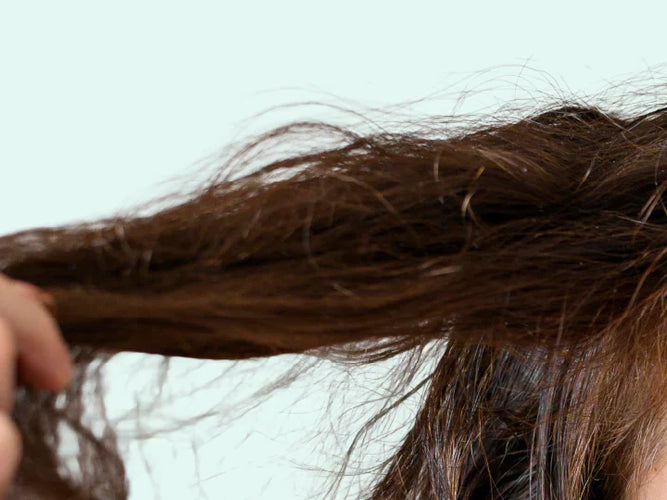Does your hair feel dull, lifeless, and prone to snapping when you brush it? You’re not alone. Brittle hair is a common issue and can be incredibly frustrating; especially when you don’t know what’s causing it or how to fix it. The good news? With the right care and knowledge, you can repair and revive your hair. This blog explains everything clearly and practically.

What exactly is brittle hair?
Brittle hair occurs when your strands lose strength. Instead of bending and bouncing back, they snap with the slightest friction or tension. Not ideal! You might notice short, uneven hairs or feel like your hair is getting thinner, even if it’s not actually falling out.
It’s important to understand the difference between hair breakage and hair loss. When hair breaks, it snaps somewhere along the length. With hair loss, the strand comes out from the root. If you spot hairs with a white bulb at the end, it's likely shedding. Seeing mostly short, broken pieces? That’s breakage.

What causes brittle hair?
Overstyling and tension
We all love a good hair day but overdoing it can backfire. Daily brushing, tight ponytails, and wearing your hair up in the same style every day put stress on your strands. If your hair is already dry or fine, this can quickly lead to breakage.
Heat, heat, heat
Straighteners, curling irons and blow dryers make hair dry and fragile; especially if used without heat protection. The more frequently you style, the more likely your hair is to break.
Chemical treatments
Dyeing, bleaching and perming might look great, but they can take a serious toll on the hair. Without time to recover, the hair structure weakens, leading to dryness, stiffness and breakage.
The weather doesn’t help either
Sun, wind, cold or pollution; they all put stress on your hair. Swimming in chlorinated or salty water without protection also causes damage over time.
What’s happening inside matters too
Your hair may break more easily if your body lacks vital nutrients like protein, iron, zinc or vitamin D. Stress, hormone changes and poor sleep can also affect hair quality.
How can you tell if your hair is breaking or falling out?
It’s not always easy to see the difference, but there are signs to watch for. Brittle hair usually feels rough or dry. You might notice short pieces at the top of your head or along your hairline. Your ends may split more easily, and detangling becomes difficult.
Hair loss is different. The fallen hair often has a white bulb at the end, and you might notice more strands in your brush or on the bathroom floor. In some cases, areas of the scalp may look thinner. Still not sure? Track the changes for a couple of weeks or consult a specialist.
What can you do to make your hair stronger?
Be gentle with your hair
- Brush carefully and avoid combing when wet.
- Use soft accessories and wear your hair down more often.
- Sleep on a satin pillowcase to reduce friction and prevent breakage.
Do you want to read more tips? Check out our blog on repairing damaged hair.
Feed your hair from the inside
- Eat enough protein and make sure you get enough iron, zinc, vitamin D and omega-3.
- If you’re feeling tired, stressed or recovering from pregnancy, a supplement may help.
Less heat, more recovery
- Let your hair air dry when you can and only use heat tools with protection
- Limit styling tools to just a few times a week; and always use a heat protectant spray.
Help your hair recover
- Use a protein or keratin hair mask once a week to strengthen your strands.
- Treat your ends with a nourishing oil or leave-in conditioner.
- Trim split ends regularly to stop further damage.
Choose better products
- Avoid shampoos with sulphates, harsh alcohol or heavy silicones. Try Neofollics Hair Growth Stimulating Shampoo.
- Go for gentle, hydrating formulas that care for your scalp and hair; like Neofollics Scalp Therapy Nourishing Mask.
When should you seek professional help?
If your hair continues to break despite all your efforts, or if you notice bald spots, itching or flaking on your scalp, it’s time to visit a general practitioner or dermatologist. A medical condition like a thyroid issue or iron deficiency may be involved; blood tests can help identify the cause.
Frequently asked questions about brittle hair
What’s the difference between brittle hair and hair loss?
Brittle hair breaks halfway along the strand; hair loss happens at the root and is often linked to hormonal or medical issues.
How long does it take to repair brittle hair?
On average, it takes 3 to 6 months to see real improvement; depending on the severity of the damage and your routine.
Which shampoo is best for brittle hair?
A mild, sulphate-free shampoo like Neofollics Hair Growth Stimulating Shampoo supports recovery without drying your hair out.
Can brittle hair become healthy again?
Yes. With the right care, diet and patience, you can bring back shine, strength and elasticity.
Does trimming help with brittle hair?
Absolutely. Cutting split ends prevents the damage from travelling up the hair shaft. Regular trims are key to healthy hair.
Conclusion
Brittle hair isn’t just a cosmetic issue; it can affect how you feel about yourself. It’s frustrating when you start your day with tangles, frizz and broken hairs on your clothes. Maybe you’ve tried everything and nothing seems to work. But you’re not alone; and brittle hair is absolutely something you can overcome.
What your hair needs is kindness. Gentle handling, mild washing, good nutrition and above all, patience. Hair doesn’t recover overnight. But with the right approach, your strands can grow back stronger, shinier and more resilient.
Don’t get discouraged by everything you see online; every head of hair is different. What works for someone else might not be your solution. That’s why it’s so valuable to tune into what your hair really needs.
Sources
Clinical study on hair growth and supplements (PubMed Central, 2024): https://www.ncbi.nlm.nih.gov/pmc/articles/PMC11694638
This information does not replace professional medical advice. If in doubt, always consult a doctor or specialist.













